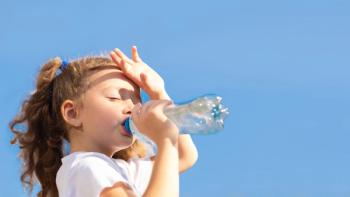What you need to know:
- CDC data from the 2024 Morbidity and Mortality Weekly Report show increased adolescent vaccination rates for Tdap, MenACWY, MenB, MMR, and hepatitis B compared with 2023.
- ≥1-dose Tdap coverage rose from 89.0% to 91.3%, and ≥1-dose MenACWY from 88.4% to 90.1%; HPV coverage remained stable at about 78% for ≥1 dose.
- Catch-up vaccination improved, with notable gains in ≥1-dose MenB (up 4.5% for age 17), ≥2-dose MMR (up 1.3%), and ≥3-dose hepatitis B (up 1.3%).
Vaccination coverage with 1 or more doses of Tdap, MenACWY, meningococcal B vaccine; 3 or more doses of hepatitis B vaccine; and 2 or more doses of measles, mumps, and rubella (MMR) vaccine increased in 2024 among adolescents aged 13 to 17 years compared with 2023.1
According to August 14, 2025, data from the CDC's Morbidity and Mortality Weekly Report (MMWR), these increases highlight the progress in increased vaccination efforts in the adolescent population.
Routine vaccine administration among adolescents
According to MMWR, the Advisory Committee on Immunization Practices (ACIP) recommends 3 routine vaccines to adolescents aged 11 to 12 years:
- Tetanus toxoid, reduced diphtheria toxoid, and acellular pertussis vaccine (Tdap)
- Quadrivalent meningococcal conjugate vaccine (MenACWY)
- Human papillomavirus (HPV)
A booster of MenACWY should be administered at age 16 years. The report stated that the COVID-19 vaccine can be received and that those aged 16 to 23 years can receive the serogroup B meningococcal vaccine (MenB). Additionally, adolescents should receive an annual influenza vaccination and catch up on any missed childhood vaccines. Since 2023, ACIP has recommended that the pentavalent meningococcal vaccine (MenABCWY) can be used when both MenACWY and MenB are indicated at the same visit.1,2
2023 vs 2024 vaccine coverage for Tdap, MenACWY, HPV
MMWR summarized coverage with these vaccines for 2024, not including influenza, COVID-19, and MenABCWY due to limited data. The report gathered data from the National Immunization Survey-Teen (NIS-Teen), an annual 2-phase survey that monitors vaccination coverage in the United States for adolescents aged 13 to 17 years. Phase 1 consists of a random-digit–dialed mobile telephone survey of parents or guardians (parents) in households with eligible adolescents aged 13 to 17 years. Phase 2 is a mailed survey to the adolescent's vaccination providers previously identified by the parent or guardian to obtain vaccine history.1
The household response rate was 21.0%. Adequate provider data were received from providers for 42.8% of adolescents with completed interviews. These 2 rates reflect different types of response mechanisms. The household response rate measures participation by households that completed the household interviews, whereas the adequate provider data rate measures vaccination data availability among those who completed the household interviews.
"To address low response rates, nonresponse adjustments are incorporated in the weighting to reduce potential bias," wrote the MMWR authors. "In addition, statistical modeling techniques such as imputation and variance estimation methods are used to handle missing data and account for the complex survey design."
Results
Among adolescents aged 13 to 17 years in 2024, coverage increases compared with 2023 were as follows:
- ≥1-dose Tdap: Increased from 89.0% to 91.3%
- ≥1-dose MenACWY: Increased from 88.4% to 90.1%
Coverage for other recommended vaccines also increased, as did catch-up vaccination in 2024 vs 2023, including for the following:
- ≥1-dose MenB: Increased by 4.5% among adolescents aged 17 years
- ≥2-dose MMR: Increased by 1.3% among adolescents aged 13 to 17 years
- ≥3-dose hepatits B: Increased by 1.3% among adolescents aged 13 to 17 years
The authors noted that in 2024, 78.2% of adolescents aged 13–17 had received one or more doses of the HPV vaccine, and 62.9% were up to date with the HPV vaccination series, similar to 2023 estimates (76.8% and 61.4%, respectively).
Overall, coverage of 1 or more doses of Tdap and 1 or more doses of MenACWY was 90% or greater in most states, highlighting progress in public health initiatives and activities to improve coverage.
"A strong provider recommendation is associated with increased likelihood of being vaccinated; however, in this analysis, adolescents living in mostly rural areas were less likely to receive an HPV vaccination recommendation from a provider than were those living in mostly urban areas," wrote the MMWR authors. "In 2024, ≥1-dose HPV coverage and the percentage of adolescents up to date with HPV vaccination were consistently higher among those who received a provider recommendation for vaccination."
References
- Pingali C, Tankey D, Elam-Evans LD, et al. Vaccination coverage among adolescents aged 13-17 years - National Immunization Survey-teen, United States, 2024. MMWR. August 14, 2025. Accessed August 14, 2025. https://www.cdc.gov/mmwr/volumes/74/wr/mm7430a1.htm?s_cid=OS_mm7430a1_e&ACSTrackingID=USCDC_921-DM149321&ACSTrackingLabel=Week%20in%20MMWR%3A%20Vol.%2074%2C%20August%2014%2C%202025&deliveryName=USCDC_921-DM149321
- Issa AN, Wodi AP, Moser CA, Cineas S. Advisory Committee on Immunization Practices recommended immunization schedule for children and adolescents aged 18 years or younger—United States, 2025. MMWR Morb Mortal Wkly Rep. 2025;74:26-29. https://doi.org/10.15585/mmwr.mm7402a2
- Fitch J. Aligning vaccinations with the start of a new school year. Contemporary Pediatrics. August 4, 2025. Accessed August 14, 2025. https://www.contemporarypediatrics.com/view/aligning-vaccinations-with-the-start-of-a-new-school-year








